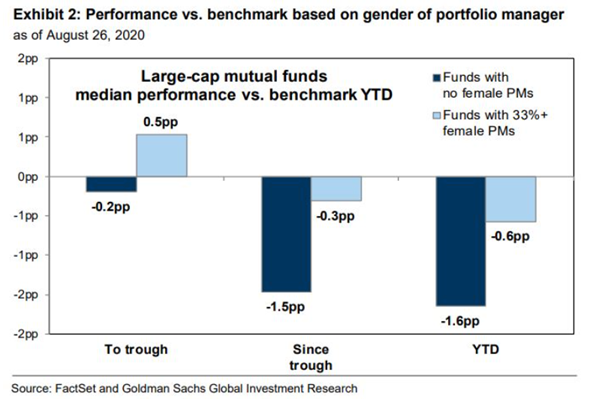In this article, we will explore the relationship of women with their money and how it is sometimes rather different than men. For a long time, the canon was to leave the finances in the hands of men, but if we look at numbers, we can quickly see that it perhaps was not the best idea.
Then, we examine how professional women investors manage their portfolios, to which extent their strategy is different – and sometimes, better – on average than men. The world of finance is not solely at the hands of men anymore, and we are starting to see visionary women like Cathie Wood shaking up the markets.
Women and their personal finances
If investing is a great way to grow wealth, it seems that some women still struggle with it, due to lower wages or lack of confidence in their skills. It is truly important to acknowledge this issue, for us to have the same chance of long-term wealth, savings, and financial prosperity. However, it seems that women compensate for their disadvantages in other ways.
Women are less confident with money than men
Historically, finances were left in the hands of men. The days where a woman had to have her husband’s approval to go to the bank are not so distant, and this has left a long-lasting mark that will take time to disappear.
A Merrill Lynch study showed that 68% of men felt capable of managing their portfolio, compared to 52% of women (maybe men are just overconfident). In all domains regarding money management, whether it was having the financial skills to save for retirement, assessing oneself to have investment knowledge, or to feel comfortable making investment decisions, it was disheartening to see that women consistently felt less confident than men, often by more than 15 percentage points or more.
However, men’s overconfidence can also be a massive disadvantage. It can lead to the overconcentration on a single position or holding a stock too long, behaviors that can destroy more values than market volatility or sell-offs.
Women are more conservative than men
Bulking up your savings accounts or loading up on bonds will not make you rich on the stock market. Stocks offer the best growth potential, as history shows. Nevertheless, it seems that women tend to invest less money in stocks than men.
Women keep 68% of their portfolio in cash or cash equivalents, vs 59% for men, according to BlackRock.
While this may seem safer and prevents major stock market downfalls, Wells Fargo suggests that women might not have enough risk in their portfolio to reach a good balance between risk and reward. While a healthy portfolio with a decent number of stocks may generate an average of 7% annually, a bond-heavy portfolio may generate just about half of this return. Assuming a $500 monthly contribution, the difference can reach a quarter of a million over 30 years.
Women are less impulsive than their male counterparts
According to a Wells Fargo study, women trade 27% less frequently than men, meaning that they react less to the market volatility. This can also be seen on the average number of logins on their investment portfolio: 3 times a week for women vs 5 times a week for men.
Vanguard also supports this theory, finding that women traded 40% less frequently than men, a trend that has been reported since the early 90s.
As some of you may know, excessive trading may lead to losses: it reduces men’s net returns by 2.65% a year, vs. only 1.725% for women.
Women can show better investment returns than men do
Speaking of returns, while women lack confidence in their investing skills, data shows that it is not justified. On average, Fidelity reported that women outperformed men by 0.4% with their annual portfolio return.
While this may seem like a small gap, it does make a difference over time: $10,000 invested with a 10% yearly return amount to $175,000 after 30 years, while the same amount with a 10.4% yearly return amounts to $194,500.
This trend of women’s portfolios has been seen since the early 90s. A study conducted by the University of California found an even more extreme conclusion and showed that women’s portfolios even had a return superior by 1% compared to men.
But why these superior returns? Well, where men are more likely to take the risk of speculation, betting on so-called “lottery-style” stocks, women will prefer to adopt a “slow and steady wins the race” style of approach, investing in funds rather than specific stocks. This meant that women had overall more diversified portfolios and typically experienced fewer losses. Women look in the future and like diversification whereas men have a more gambling attitude.
Professional women investors might be better than men, too
When it comes to the world of finance, there’s no shortage of male presence. However, their large number does not mean that they are better performers, far from it. Now that we saw that men and women have different preferences in regard to how they manage their personal finances, we will look at professional portfolio managers and see how having female PMs can impact a fund.
An overall outperformance
Based on newer research, it was found that women fund managers regularly outperformed their male counterparts. This time though, it seems to have nothing to do with risk aversion as some older studies suggested, but more with high-quality decision-making skills.
A recent study by Goldman Sachs showed that 48% of female managed funds outperformed the market in the last year, compared to only 37% for all-male funds. Women-led funds also showed greater resilience during the March downfall of 2020.
The same scheme was observed from 2000 to 2009, with women-managed funds delivering almost double the performance, and much higher resistance to the 2008 crisis, falling 9.6% in value on average vs. 19% for male-run funds. What are the reasons behind this?
Of course, not all studies support this. A Morningstar study was more nuanced, showing that women were better at managing fixed-income instruments (only slightly) and men were better at managing equity funds (but only slightly, as well).

Women have a positive impact on decision-making
Women bring something important to the table when a group needs to make decisions, such as which stocks to buy. They tend to have better listening skills, and the capacity to consider diverging viewpoints and opinions.
This idea is supported by academic research, as it states that the presence of a diversity of any kind improves the decision-making quality and comprehensiveness in a group, stopping it from engaging in what we call “groupthink” – when everyone will simply follow the average tendency of the group.
Further research found that companies with women in the top management also performed better. Researchers suggest that women tend to have a management style that encourages listening and sharing, sparking up new and better ideas at a higher frequency.
Women take… more risks!
While this may seem contradictory compared to what we have said in the first part of this article, unlike in their personal finances, women are not more cautious in the professional world. On the contrary.
The difference is that the risk aversion difference that has been observed between men and women is a socially constructed one. Women tend to be more cautious with their personal finances because of stereotypes imposed on them.
When they enter the business world and have more female colleagues, this outside pressure lifts off, and they take more risks. This even has a snowball effect in mixed teams: when men see women take more risks, they feel threatened and respond by taking more risks, too. Seems like both women and men struggle with external social pressures regardless of one's sex.
Conclusion: are women better investors than men?
Regarding personal investments, it seems that lower confidence leads women to take less risky positions. They also invest smaller sums of money because of an income that is on average smaller than men's.
However, this is compensated by the fact that they do seem to be more patient and careful, with less trading frequency and overall, better return on investment on their account as they make fewer mistakes. A more risk-averse strategy with a higher portion of their salary saved gives them a solid approach to maintaining their capital for the future.
In the professional world, women-led funds tend to outperform men-led funds, as diversity leads to more quality decision-making. It was even found that the risk aversion experienced in their personal finances disappears.
At the end of the day, the empirical proof paints a clear picture: Portfolios of women managing self-directed retail investment accounts outperform portfolios of men managing self-directed retail investment accounts by a significant amount, especially when you project towards the future.





